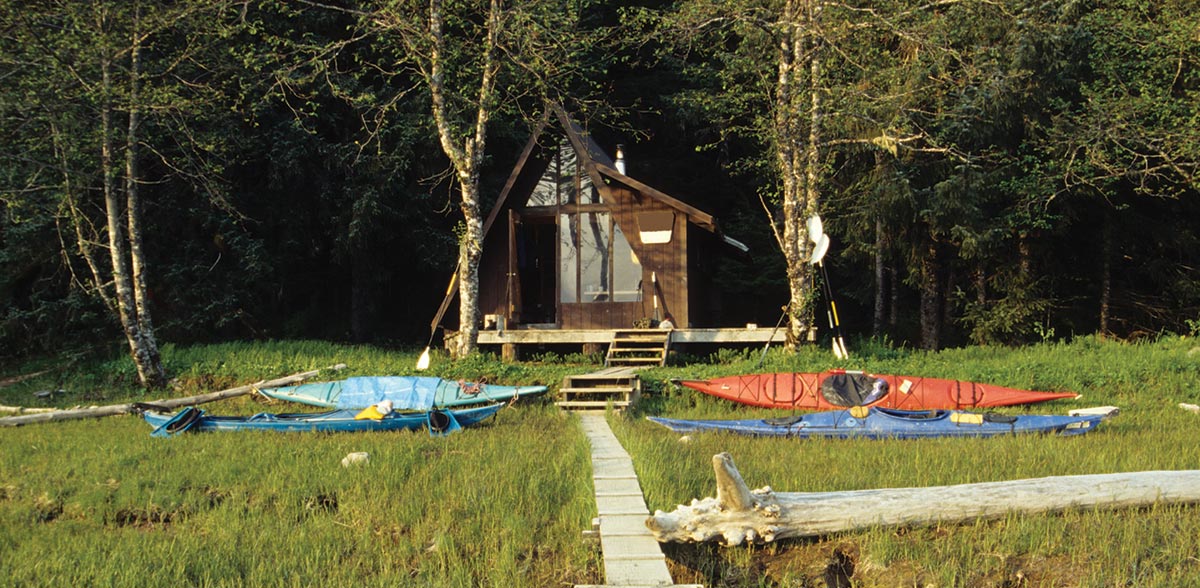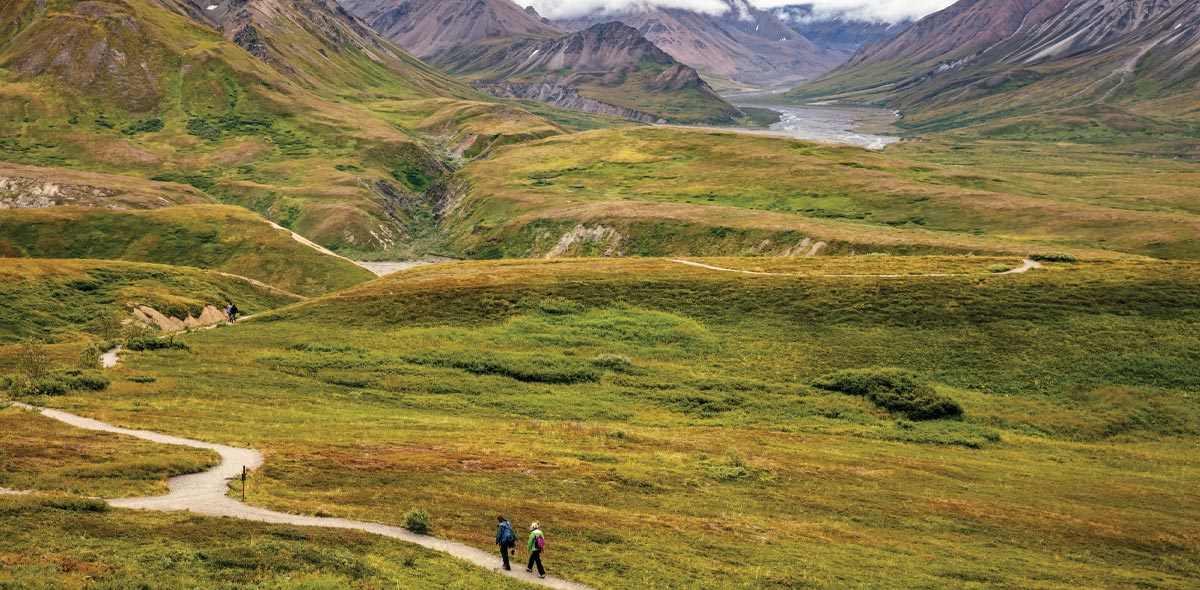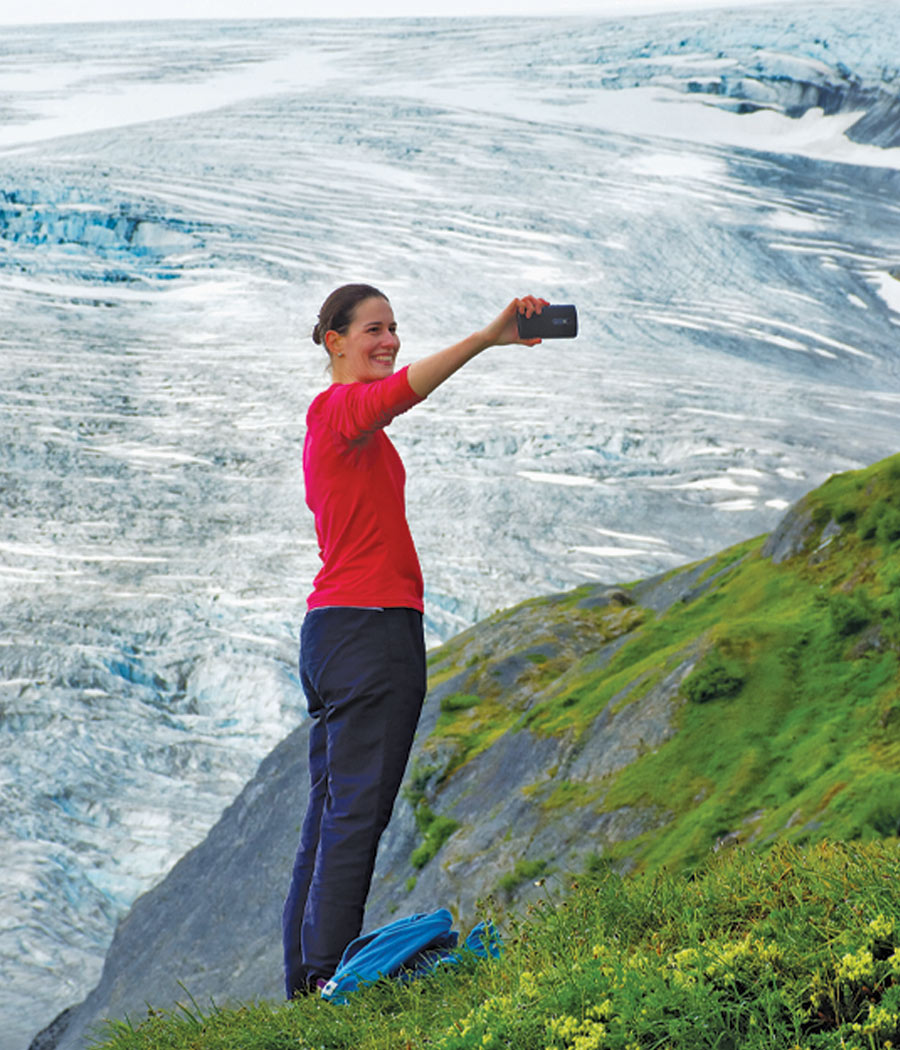Gaining Traction
visitor experiences
he Ted Stevens Anchorage International Airport and the state’s ports and other vital gateways for long-haul tourism destinations are what most think of when it comes to tourism infrastructure. However, community visitor centers, roadside cabins, and robust trail systems are also essential parts of the infrastructure needed to support this multi-billion dollar sector in Alaska.
“We lack tourism infrastructure all over the state,” says Bonnie Quill, president and CEO of the Mat-Su Convention & Visitors Bureau. “What tourism infrastructure does is it increases the visitor experience, whether it’s a visitor center or a trailhead or the new ski lift at Hatcher Pass.”
Improved infrastructure that connects visitors to communities and businesses has a positive economic impact, Quill explains.
And the longer visitors stay, the better, says Alaska Trails Initiative Coordinator Chris Beck.
“When you look at the length of stay in Alaska versus some of our competing destinations, stays in Alaska generally are fairly short,” Beck says. “In New Zealand, a place that has invested in substantial, active outdoor recreation infrastructure, particularly trails and hut-to-hut systems… the average stay is nineteen days. In Alaska, it’s only nine days.”
Those trail infrastructure development projects in New Zealand are integrated with private businesses that profit from the infrastructure, Beck says.
Based on Alaska Visitor Statistics Program VII, Beck estimates that if half of the out-of-state visitors during a typical year spent one more day in the state, they would spend $137 million more annually.
“We can do more to provide a diversity of ways to deliver what people really seek in Alaska, that intimate experience of our wilderness, wildlife or mountains or glaciers. Trails are an essential part of the infrastructure that delivers that experience,” Beck says.
“While a trail may not come to mind, like a bridge or a port, if the goal is a strong and diverse and sustainable economy, trails, trailheads, and huts are all really high on the list of the infrastructure that delivers those experiences and those economic benefits.”
Despite a lack of investment, nature walks and hiking have seen the greatest increase of all categories of Alaska visitor activities, according to Alaska Visitor Statistics Program VII. In 2011, 38 percent of tourists who flew into the state participated in hikes, increasing to 46 percent by 2016. There was about a 6 percent increase in participation over the same time period by those coming to the 49th State as part of a cruise.
While the COVID-19 pandemic has had a devastating impact on the seasonal tourism industry in Alaska, some opportunities for tourism development projects have opened up through the CARES Act.
Alaska received about $1.25 billion in CARES Act funds, and some of that money has already been tagged for tourism infrastructure projects.
“The piece that has been significantly lacking is investments on state land,” Beck says. “Chugach State Park, the backdoor wilderness area in Anchorage, has received virtually no money for trails in the last ten to twenty years.”
However, that changed with the CARES Act. The heavily eroded popular trail up O’Malley Gully in Chugach State Park was one of several projects funded with $546,000 set aside by the municipality for a public land jobs program, Beck says.

mlharing | iStock
The trail building project created eleven new jobs and provided an investment for the tourism industry that can be leveraged once the nation begins to recover from the pandemic.
But the Alaska Trails Initiative’s flagship project is The Alaskan Long Trail—the Last Frontier’s answer to the Lower 48’s Appalachian Trail.
The goal is to create a single trail system linking Fairbanks to Seward, Beck explains.
“As the Appalachian Trail example shows, when they [smaller trail systems] become part of this longer, branded, internationally-known experience, there is sort of this magic dust sprinkled on those routes,” he says. “Now people go out of their way to find them.”
Even if someone isn’t a thru-hiker, the attraction of hiking a section of an iconic trail system has significant draw for tourists, Beck says.
Another shovel-ready project that is positioned to benefit from the CARES Act is the Mat-Su Convention & Visitors Bureau.
In 2010 there was a feasibility study to look at relocating and rebuilding the Bureau after it had been nearly encompassed by the Mat-Su Regional Medical Center, decreasing visibility and access, Quill says.
Community leadership settled on the Gateway Visitor Center, to be built on the Glenn Highway between the Parks Highway interchange and Palmer.
Mat-Su Convention & Visitors Bureau secured funding for the land, as well as approximately $2 million for the design of the center, which was done by Alaska-based Wolf Architecture; however, raising the $8.4 million needed for construction has been a struggle.
“We’ve been looking for federal grants, and it’s really heartbreaking that the pandemic created an opportunity,” Quill says. “We hired grant writers and submitted an application for an EDA [Economic Development Administration] CARES Act grant. The CARES Act really had a lot of funds for immediate relief for businesses, but the EDA grants were more of a long-term economic benefit, which this would provide.”

ovidiuhrubaru | iStock
“So, within the interpretive plan and design, there’s a little area that we talk about our agricultural and Alaska Grown, but we then provide [visitors] with interpretive information, where they can go have those experiences, visiting a ‘you-pick’ farm or going to one of our local markets.”
When the request for proposal for the design was put out, there was a huge response from architects, Quill says.
“These are the kinds of projects that they really enjoy designing,” Quill says. “We had an advisory group of people from different organizations from our museums and historical societies and local businesses that provided feedback to the architects.”
Ultimately, Wolf Architecture won the contract.
Tourism infrastructure, such as a visitor center, needs to be able to create a bridge between the opportunities a place offers and the people wanting to experience them, explains Chris Whittington-Evans, an architect with Wolf Architecture.
“It’s done in part through digital means and methods, but the boots on the ground approach is still relevant and it really is still vital to visitors getting good information,” he says. “We had to, as designers, kind of take both of those approaches into consideration when looking at the Gateway Center.”
Gary Wolf, also an architect with Wolf Architecture, says one of the reasons his firm was selected for the project was the team’s intimate knowledge of the area and what it has to offer to visitors.

Eder Maioli | iStock
Whittington-Evans points out that the premier trail system in the borough is across the Glenn Highway from the new center’s location.
“The interesting thing about this particular opportunity is that it’s not just about public lands or trails or whatnot. It’s really trying to be as the name implies; a gateway to those trails but also to small businesses and nonprofits.”
Once funding for the build is greenlit, a request for proposal will be put out for a construction contractor.
“I don’t think there’s anyone in Alaska who can specialize in constructing visitor centers but there are a myriad of qualified contractors who do great work,” Whittington-Evans says. “We’ve designed it to be aesthetically pleasing and to capture the views of Chugach.”
Given the site’s proximity to Anchorage, Wolf and Whittington-Evans expect to see many Anchorage contractors bidding on the project. While an Alaska construction company will likely be selected to do the build, the interpretive work inside the building will most likely be subcontracted to a firm Outside.
“What will be a specialized aspect of this project is the exhibit design and fabrication and construction that will go into the interior of the project,” Wolf says. “For example, the graphical displays of the trail systems and three dimensional maps of the parks.”
Wolf says there simply aren’t enough public dollars being spent on this type of specialty work in Alaska to keep a business focused on such creations in the black.
“The infrastructure is needed so that people can access, or have appropriate access, to our wild lands, into our waterways, into our park lands and public lands.”
Leonard recognizes that the tourism sector’s recovery from the pandemic will likely be slower than originally anticipated. However, she says the industry will certainly play an important role in the state’s overall economic recovery.
“Alaska has the most public lands of any state, by far,” Whittington-Evans says. “We benefit from developing our public lands. And that includes the development of pathways to experiences. Experiences are what people pay top dollar for.” ![]()